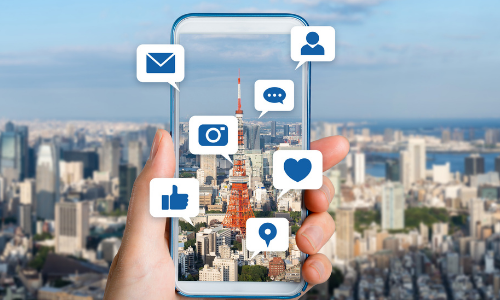By Pam Fields, CEO, ATECH
The degree to which individuals are interconnected and embedded in a community has a powerful impact on their health and personal wellbeing. Social isolation is typically defined by a low frequency of social contact, and is often associated with lower quality of wellbeing. Recent research has been giving attention to whether loneliness is an indicator of low social connectedness or social isolation, and other studies are looking at the relationship between loneliness and social isolation.
It is our belief that assistive technology can be used by individuals experiencing barrier issues including those with intellectual developmental disorders or Autism, as well as seniors aging in place, helping them take steps towards establishing a greater level of independence and improving their wellbeing. There are also assistive technology devices that assist people in combating loneliness and social isolation.
Findings from a study conducted by Karina Alibhai of the Samuel Centre for Social Connectedness show that technology can be used to reduce social isolation among seniors aging in place and in group home settings. Alighai’s research on various tools found a positive correlation between technology use and levels of social and community connectedness.
Tools to Combat Social Isolation
There are several categories of technology that have been studied as tools to lessen social isolation, and many have been shown to successfully reduce the loneliness, depression and anxiety commonly experienced by many people. These technologies include mobile tech, videoconferencing, internet and communication technologies, games, social networks, and mobility tools.

Common Misperceptions
Before we get into the details of the assistive technologies, I wanted to take a moment to address a common misperception among some families and caregivers. Some people believe that using assistive technology (AT) for social engagement is akin to giving someone an iPad and letting them watch videos all day because it’s what they want to do. That is not true engagement, and that is not the goal of using AT as a social engagement tool.
For an individual in a direct care setting, leaving them alone to sit by themselves for hours on end with no interaction with anyone except a device or piece of technology, is not an engaged or informed choice. Instead, we see technology use as an opportunity for a staff member to get the individual engaged in a more productive way, to encourage them to take part in a conversation or in some other activity, using tech as a support. The technology is a tool, and used effectively can be a powerful solution in helping combat social isolation.

AT As Part of A Holistic Approach
At ATECH, we believe that AT can be used as part of an overall holistic approach to helping the individual move towards independence. Other elements of this approach include
- Natural/family supports and interaction
- Community and friends
- Paid and unpaid Staff support and communication
Assistive technology is just one tool among many in the holistic approach to care. Assistive technology is not a “plug and play,” or “set it and forget it” kind of a solution– it needs to be tailored to the individual to be truly successful and it frequently changes over time. Assistive technologies are tools for getting individuals more engaged with each other and with the community at large, combating loneliness and isolation, and boosting their personal wellbeing.
Mobile Technology for Communication
Technology that facilitates communication, like email, video calls including Skype, Facebook Portal, or Zoom can be especially appreciated in the case of people who have physical and cognitive disabilities. These individuals commonly experience feelings of isolation, frustration and depression. Using communication-based technologies via a mobile phone or tablet can give these individuals the ability to share their experiences with others, forging new connections, sometimes with those who have the same diseases or disabilities. This newfound sense of understanding and community can provide high levels of emotional support and greatly increase wellbeing.
Mobile technology’s ease of use is an additional factor in helping to keep individuals connected with family and friends. Many seniors can be technophic, and individuals with IDD or Autism may need some coaching at first, but once they become comfortable with the use of a mobile app, their experience deepens and their sense of control and independence increases.
Assistive technology can be used to help people overcome mobility challenges and help them to stay better connected. New mobile apps are being developed and launched to identify different transportation routes in cities and towns, making it easier to set up transportation and stay in touch with the community. These new mapping apps help mitigate social isolation by providing transportation options to get people to where they want to go and give them information about places where others are connecting in person. Drive sharing apps like Uber and Lyft are easy to use, and provide individuals with private transportation to and from community events, or meetups with friends.
Video Conferencing
Many people prefer face-to-face interaction, but with the COVID-19 pandemic’s social distancing policies, geographic and mobility barriers have frequently prevented in-person meetings. Video conferencing technologies like FaceTime, Skype, or Facebook Portal, have bridged the physical gap and allowed people to stay connected.
One Canadian study focusing on seniors aging in place found that even five minutes of weekly video conferencing interaction with family over a three month time span alleviated depression symptoms and loneliness. Similarly, for individuals with IDD or Autism, after the initial introduction to the technology, connecting with a staff or family member online via a video conference becomes a way to read stories together, play games, or just talk.
Additionally, research is now being done by long-term care and assisted living facilities in the use of companion robots to ease loneliness for their residents. Sophisticated robots, like the ElliQ, are specifically used for engagement and social companionship. Some robots tell jokes, some play music, while others offer mindfulness exercises or play exercise videos to keep seniors engaged, thinking, smiling and moving.

Online / Digital Games
The growth of online or digital gameplay in the past few years has been staggering. The range and scope of digital games continues to expand exponentially, and the immersive experiences of virtual reality offer many online players the ability to engage in a way never before possible. Many games allow players to interact with each other, simply connecting and talking or working together to solve problems. Avatars and role-playing games also allow people to interact with each other in a way that equalizes the playing field.
Additionally, research has found that digital gameplay has socio-emotional benefits and can help develop relationships that strengthen social ties, both on and offline. – not sure this is pertinent to our population as a whole…
Social Media
Social media provides a quick and simple way for many individuals to engage in meaningful social contact. For older adults aging in place, using social media can be extremely beneficial in finding needed support in dealing with a challenging life event. Finding like-minded individuals who are interested in the same hobbies or activities also helps connect individuals with a built-in network of others who share their likes and interests. All of these activities combat feelings of loneliness and isolation, providing emotional comfort and support, while improving overall wellbeing.

Conclusion
Assistive technology can be used in many different ways for a wide variety of purposes. Helping to connect individuals to friends, family, and the community at large through the use of assistive technology not only helps fight against isolation and loneliness, but also provides a deeper sense of belonging. New research is showing this greater sense of wellbeing can positively impact overall health.
Assistive technology tools are an integral part of looking at each individual from a personalized, holistic approach. In our role as caregivers, helping an individual move towards independence is an ongoing goal. Using assistive technology to positively impact socialization and community involvement while providing an easy to use and comfortable tool helps both the individual and the caregiver.
To learn more about Assistive Technology and Membership in ATECH, contact us.
For more timely articles on Assistive Technology, visit our News & Events page.

